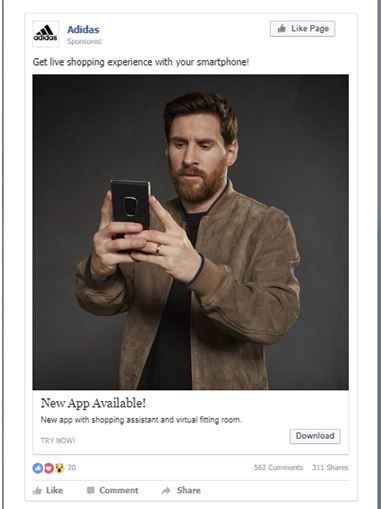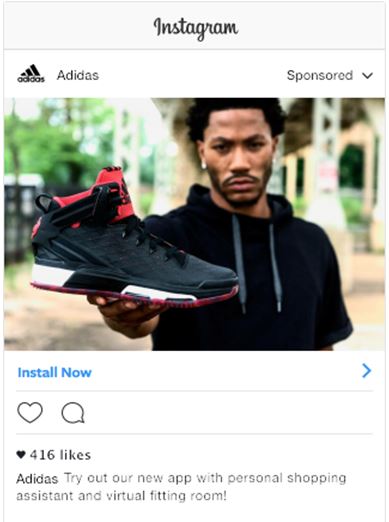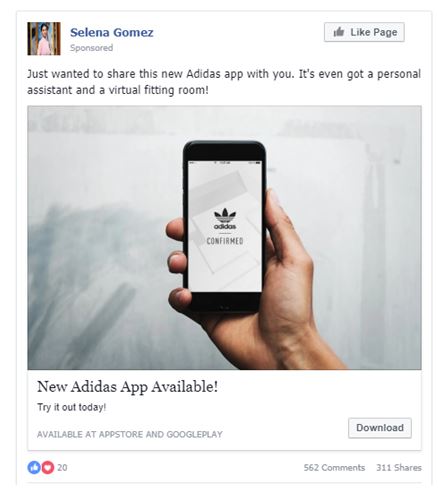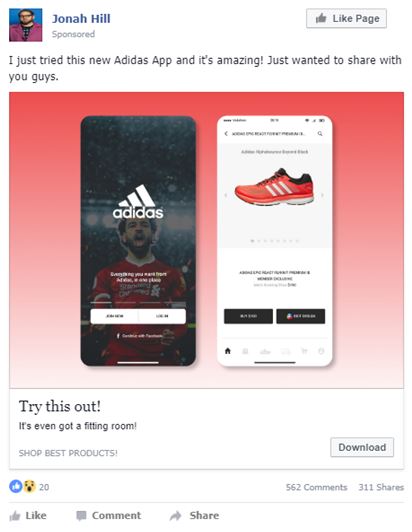Introduction
The presented service idea is strongly associated with the global pandemic, which has greatly influenced the international and domestic markets (Texel, 2020). This paper proposes a service marketing strategy based on these factors and the characteristics of the new service idea presented in the previous paper. It provides a critical evaluation of this strategy, as well as an explanation and design of the new service promotion by applying the extended marketing mix (7Ps) and a detailed promotional plan. The paper also considers and explains what skills and knowledge are needed for a service manager.
Marketing Strategy
Critical Evaluation
The proposed idea involves introducing a new Adidas product personalized selection and delivery service based on a specific type of activity of a customer within a mobile application. This implies that the new service will offer unique value to clients, as people will have the opportunity to choose clothes, check how they look and fit using a simulation, and buy them without leaving home. For a new mobile application service to work effectively, it is necessary for people to be engaged, and an effective marketing strategy should be used (Texel, 2020).
In this context, it is possible to state that the Value-Based Strategy is less suitable for this case. The reason is that customers’ willingness to pay a high price for this service is not known yet in spite of the company’s reputation as the service is new (Lopez, 2020). In order to effectively promote a new application, more attention should be paid to examining customers’ expectations.
It is also important to note that the Services Theatre approach is also an irrelevant marketing strategy for this situation, as performance and human relationships play a supporting role in this case (Baker, 2007; Grove and Fisk, 2004). The proposed service takes place entirely in the digital space, which also makes this strategy inappropriate. Customer-Dominant Logic (CDL) is associated with a focus on customer-related factors, such as entertainment and personal experiences (Baker, 2007; Tynan, McKechnie and Hartley, 2014). Still, CDL creates a risk that the inappropriate selection of target customers for the offer can prevent the service from its further development as a provider’s logic should also be taken into account.
Service-Dominant Logic (SDL) seems to be a more appropriate framework in this regard, as it implies active customer involvement in creating service value, but it addresses the weaknesses of CDL. According to Werner, Griese, and Hogg (2017), this approach is in opposition to the traditional Goods-Dominant Logic (GDL). The focus shifts from the intrinsic value of specific goods to a constructivist approach to value creation within certain market conditions. This means that the creation of the service’s value takes into account the socio-cultural features inherent to a particular period and society (Werner, Griese and Hogg, 2017). This characteristic of SDL fully corresponds to the proposed service idea, which is the company’s response to the specific global situation.
Strengths
The SDL approach has many strengths because of being oriented to clients, accentuating the value-in-use. According to Vargo and Lusch (2006), the service provider can make value propositions and allow customers to decide what is essential for them. These propositions can be similar around the globe, and at the same time, the promoted values are quite evident during the pandemic, as people cannot leave home and try new clothes on.
Offering an innovative mobile application for buying products and applying the SDL approach, Adidas will refer to the experiences of customers to co-create the value and characteristics of the product. The factor of customization will be addressed, and the flexibility of the SDL approach will allow for making necessary arrangements in the application because the marketing strategy is easily modifiable in its nature, which of extreme importance in modern realities (Vargo and Lusch, 2017). Finally, the approach is based on a dialogue with a customer, which is positively associated with customer satisfaction (Vargo and Lusch, 2017).
Possible Problems
Possible problems with the marketing strategy are embedded in the nature of the approach and should be considered when creating an implementation plan. First, the implementation of such a marketing strategy requires specialized skills and knowledge due to a high probability of failure (Vargo and Lusch, 2006). Thus, Adidas will need to find talents to implement the strategy at an adequate level, which may be costly. Second, the customer is always a co-creator of the product, which makes it impossible to make long-term predictions for the marketing campaign (Vargo and Lusch, 2006). This implies that the strategy will need to be modified frequently, depending on customers’ feedback (Vargo and Lusch, 2017). Finally, Campbell, O’Driscoll, and Saren (2013) state that SDL is overfocussed on immaterial objects, which may potentially cause problems with tangible entities, such as clothing and the application, which can cause problems. It is important for marketers to realize the SDL strategy in contrast to CDL or GDL because all these approaches are based on the value concept, but only SDL allows for value co-creation without ignoring a provider’s interests.
Extended Marketing Mix Application
The extended marketing mix is a widely used tool by businesses and Marketers that helps to determine a product or brand offering. It is also called the 7Ps, as it is based on understanding and positioning the product, place, price, promotion, people, processes, and physical evidence (Pogorelova et al., 2016). The 7Ps approach is usually used to conduct a marketing audit and identify the strengths and weaknesses of the strategy (Pogorelova et al., 2016). Even though it is vital to assess all the Ps to acquire a holistic picture, the present paper will only focus on four of them in accordance with the priorities of the marketing strategy. According to SDL, physical evidence and price are not primary concerns (Vargo and Lusch, 2017). Moreover, as the place is the Internet, it is also not critical to focus on the physical evidence and price issues. Therefore, the present paper will discuss people, processes, products, and promotion from a unique perspective of applying these components along with the SDL approach.
The service provision process consists of four stages following Service Blueprint: (1) selection, (2) virtual fitting room, (3) expert consultation, and (4) delivery. This sequence should be communicated during the promotion. It will let customers know that the service reflects all the stages of real shopping. During the pandemic and quarantine measures around the globe, it is expected to be valuable for customers to experience the same benefits of real shopping without leaving home. The process is coherent with the SDL, as the process is an intangible entity, which is one of the central values promoted to the customer. The customers, however, will be able to modify the process to fit their individual needs, which is vital, according to SDL (Vargo and Lusch, 2006).
Even though the products remain the same and only the way of distribution changes, the mobile application should also be acknowledged as a new service. As an innovative service, it should be coherent with the values promoted by Adidas and adhere to the strict quality requirements applied to other products. The company considers the quality of the products as one of the central benefits delivered to the customers (Adidas, 2019). Therefore, it is central to ensure and emphasize the quality of the new application. This is also coherent with the SDL, as the quality is an intangible object.
The particular emphasis should also be placed on the fact that people are active participants in the process. According to SDL, customers are co-creators of the product, and their feedback is the driver for improvement (Vargo and Lusch, 2006). Since the target audience of the application are sports enthusiasts around the world, Adidas will only suggest values for the customer, and the people will create their product. The ability to customize the product in accordance with people’s particular needs is central for multi-national companies with highly diverse customers. The opportunity to tailor the application is also vital coherent with SDL.
The above elements of the extended marketing mix refer to the information that will be communicated to the customers through the promotional campaign. It will consist of a description of the service provider’s and customers’ joint participation in creating the relevant value and the benefits acquired. Adidas provides a digital shopping platform as well as innovative tools to bring the online process as close to reality as possible. Customers test this platform, buy products, and share their views on performance and possible recommendations for improvement. In this way, producer-consumer relationships are re-engineered into the new environment.
Promotional Plan
The promotion plan needs to marketing communication required to launch the new service effectively. Moreover, it needs to include any other potential marketing activities that may be taking place in the organization. Figures 1-4 are mockups of the social media campaign and influencers’ posts. Table 1 below demonstrates a detailed promotional plan considering that the launch of the product is July 1, 2020. All the dates in the first column should be shifted considering the actual launch date of the application.




Table 1. Promotional Plan
Required Skills and Knowledge
As an industry executive, I will need to possess certain knowledge and skills to manage the new service effectively. First, I will need a detailed understanding of the process of idea formation, new service development, designing a marketing strategy, and service launch (Zeithaml, Bitner and Gremler, 2009). This course and the tasks presented have provided me with this knowledge to a large extent and allowed me to practice the skill initially. Second, I should acquire an empathic understanding of customers to assess their current needs to improve the ability to serve them effectively (Fisk, John and Grove, 2008). Another crucial skill is the capability to understand users and their needs (Hertog, Aa and de Jong, 2010). I understand my customers; however, I do not yet have enough knowledge about strategies to assess the needs of customers. To a large extent, it is gained with experience and time spent on professional development in a particular industry.
Another essential skill that requires specific theoretical knowledge is the development of service hypotheses and their verification through market research. I need some practice to develop and improve it. Researchers state that “service innovators have to make sure they are informed about the latest options that technologies offer in their industry and related trades” (Hertog, Aa and de Jong, 2010, p. 499). This skill is particularly relevant to the proposed service discussed in this paper. An industry executive should have not only knowledge about service development and marketing strategies but also understand modern innovation technologies related to service promotion. This refers primarily to popular social media and user experience on the Internet.
In summary, before entering the present course, I had little understanding of how a new service is launched. Even though I felt that I have enough skills to understand my clients’ preferences, I did not have the knowledge about efficient strategies to assess customer needs. The present course has granted me with structured knowledge about the process of launching and promoting a new service. It has given me a substantial theoretical background, which I can use for making decisions in the future. I still need to acquire skills to conduct market research and analyze marketing data to adjust my decisions in the future.
Conclusion
It should be concluded that Service-Dominant Logic is the most appropriate for this proposed service idea. This service involves the co-creation of the service value by the producer-consumer communication transferred to the digital space through the mobile application. The core elements of the marketing mix in this regard are the process and promotion that will take place predominantly in social media. Promotional activities will also be carried out in the digital space, which is the environment of the service. This is the most effective and appropriate in the context of quarantine measures.
References
Adidas (2019) Annual Report 2019. Web.
Baker, M. J. (2007) Marketing strategy and management (4th edn.) Hampshire: Palgrave Macmillan.
Campbell, N., O’Driscoll, A. and Saren, M. (2013) ‘Reconceptualizing resources: A critique of service-dominant logic’, Journal of Macromarketing, 33 (4), pp. 306-321.
Fisk, R. P., John, J. and Grove, S. J. (2008) Interactive services marketing (3rd edn.) Boston: Houghton Mifflin.
Grove, S.J. and Fisk, R. (2004) ‘Service theater: An analytical framework for services marketing’, in Lovelock, C.H. and Wirtz, J. (eds.) Services marketing: Text, cases, and readings. Upper Saddle River: Prentice-Hall, pp. 78-87.
Hertog, P., Aa, W. and de Jong, M. W. (2010) ‘Capabilities for managing service innovation: towards a conceptual framework’, Journal of Service Management, 21 (4), pp. 490-514.
Lopez, S. (2020). Value-based marketing strategy: Pricing and costs for relationship marketing. Wilmington: Vernon Press.
Pogorelova, E., Yakhneeva, I., Agafonova, A. and Prokubovskaya, A. (2016) ‘Marketing mix for e-commerce’, International Journal of Environmental & Science Education, 11 (14), pp. 6744-6759.
Tynan, C., McKechnie, S., and Hartley, S. (2014) ‘Interpreting value in the customer service experience using customer-dominant logic’, Journal of Marketing Management, 30 (9-10), pp. 1058-1081.
Texel (2020) How COVID-19 will reshape fashion retail? Web.
Vargo, S. L. and Lusch, R. F. (2006) Service-dominant logic: What it is, what it is not, what it might be. Web.
Vargo, S. L. and Lusch, R. F. (2017) ‘Service-dominant logic 2025’, International Journal of Research in Marketing, 34 (1), pp. 46-67.
Werner, K., Griese, K. M. and Hogg, J. (2017) ‘Service dominant logic as a new fundamental framework for analyzing event sustainability: A case study from the German meetings industry’, Journal of Convention & Event Tourism, 18 (4), pp. 318-343.
Zeithaml, V. A., Bitner, M. J. and Gremler, D. D. (2009) Services marketing: integrating customer focus across the firm (5th edn.) London: McGraw Hill.